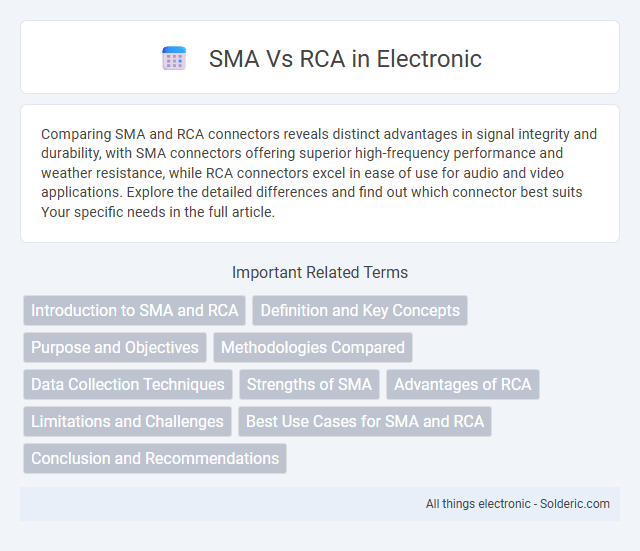Comparing SMA and RCA connectors reveals distinct advantages in signal integrity and durability, with SMA connectors offering superior high-frequency performance and weather resistance, while RCA connectors excel in ease of use for audio and video applications. Explore the detailed differences and find out which connector best suits Your specific needs in the full article.
Comparison Table
| Feature | SMA (Surface Mount Assembly) | RCA (Root Cause Analysis) |
|---|---|---|
| Definition | Process of assembling electronic components directly onto the surface of printed circuit boards (PCBs). | Problem-solving method for identifying the underlying causes of faults or problems. |
| Purpose | Efficient, automated circuit board assembly. | Identify, analyze, and resolve defects or failures. |
| Application | Electronics manufacturing, PCB assembly lines. | Quality control, process improvement, maintenance. |
| Focus | Physical assembly of components. | Investigation of cause-effect relationships. |
| Outcome | Completed electronic assemblies ready for use. | Recommendations and corrective actions to prevent recurrence. |
Introduction to SMA and RCA
SMA (Service Mobility Architecture) is a framework designed to enhance seamless service delivery across various network environments by managing mobility and service continuity efficiently. RCA (Root Cause Analysis) is a systematic process used to identify the fundamental origins of faults or problems within systems, aiming to prevent recurrence and improve overall performance. Understanding both SMA and RCA enables you to optimize network reliability and troubleshoot issues effectively.
Definition and Key Concepts
SMA (Shape Memory Alloy) is a unique material that can return to its original shape after deformation when exposed to heat, relying on phase transformations between austenite and martensite. RCA (Root Cause Analysis) is a systematic process used to identify the fundamental reasons behind a problem or failure, emphasizing techniques like the 5 Whys and Fishbone diagrams. Understanding these distinct definitions helps your team apply the correct approach, whether addressing material science challenges with SMAs or troubleshooting issues using RCA methodologies.
Purpose and Objectives
SMA (Shape Memory Alloy) technology is primarily designed for applications requiring materials that can return to a predetermined shape upon heating, emphasizing mechanical adaptability and precise actuation in fields like robotics and medical devices. RCA (Root Cause Analysis) focuses on systematically identifying the underlying causes of faults or problems within processes or systems to prevent recurrence and improve operational efficiency. The purpose of SMA centers on improving material functionality through reversible deformation, whereas RCA aims at enhancing problem-solving and process optimization through detailed investigative techniques.
Methodologies Compared
SMA (Simple Moving Average) smooths price data by averaging a set number of past periods, offering a straightforward trend analysis method that filters out short-term fluctuations. RCA (Rolling Correlation Analysis) measures the dynamic relationship between two assets over a moving window, providing insights into changing market dependencies and co-movements. Your choice between SMA and RCA depends on whether you need to identify price trends or analyze the correlation dynamics between financial instruments.
Data Collection Techniques
SMA (Simple Moving Average) and RCA (Relative Cumulative Average) utilize distinct data collection techniques to analyze trends over time. SMA gathers data points sequentially over fixed periods to calculate an average, smoothing short-term fluctuations, while RCA accumulates data relative to a baseline to emphasize cumulative changes. Understanding these approaches helps you select the most effective method for your data trend analysis needs.
Strengths of SMA
SMA (Separative Magnetic Analysis) offers superior selectivity and higher resolution in distinguishing complex magnetic components compared to RCA (Root Cause Analysis). Its advanced spectral analysis capabilities enable more precise identification of subtle magnetic signatures critical in material characterization and quality control. SMA's enhanced sensitivity and data accuracy improve diagnostics in fields such as geophysics and biomedical research.
Advantages of RCA
Root Cause Analysis (RCA) offers comprehensive identification and resolution of underlying issues, leading to long-term problem prevention rather than temporary fixes. By systematically analyzing cause-and-effect relationships, RCA improves process efficiency and reduces recurrence of errors. This method enhances organizational learning and decision-making through detailed insights into complex problems.
Limitations and Challenges
SMA (Shape Memory Alloy) actuators face limitations such as low energy efficiency, slow response time, and fatigue after repeated cycles, restricting their use in high-speed or heavy-load applications. RCA (Rotary Control Actuators) encounter challenges including mechanical complexity, maintenance requirements, and limited torque-to-weight ratio, which can hinder performance in compact or lightweight systems. Both technologies require careful consideration of application-specific demands to optimize durability, responsiveness, and operational lifespan.
Best Use Cases for SMA and RCA
SMA (Special Memory Addressing) excels in high-speed data retrieval and processing within embedded systems and real-time applications, making it ideal for use cases where rapid memory access is crucial. RCA (Ripple Carry Adder) is best suited for arithmetic operations in digital circuits, particularly in low-power and resource-constrained environments requiring simple, compact designs. Your choice between SMA and RCA should depend on whether the priority is memory management efficiency or arithmetic computation simplicity.
Conclusion and Recommendations
SMA and RCA each offer distinct advantages for data analysis and decision-making, with SMA excelling in smooth trend detection and RCA providing deeper insight into root causes of issues. For businesses prioritizing short-term trend monitoring, SMA is recommended due to its simplicity and clarity. Organizations facing complex problems should adopt RCA to identify underlying factors and implement effective solutions.
SMA vs RCA Infographic

 solderic.com
solderic.com